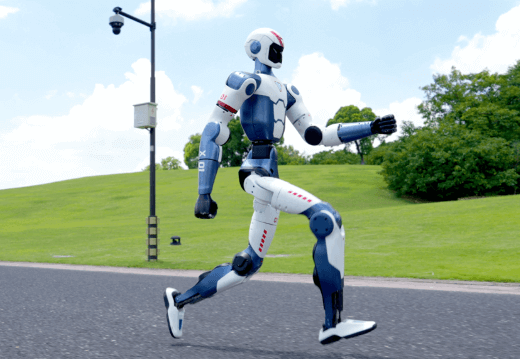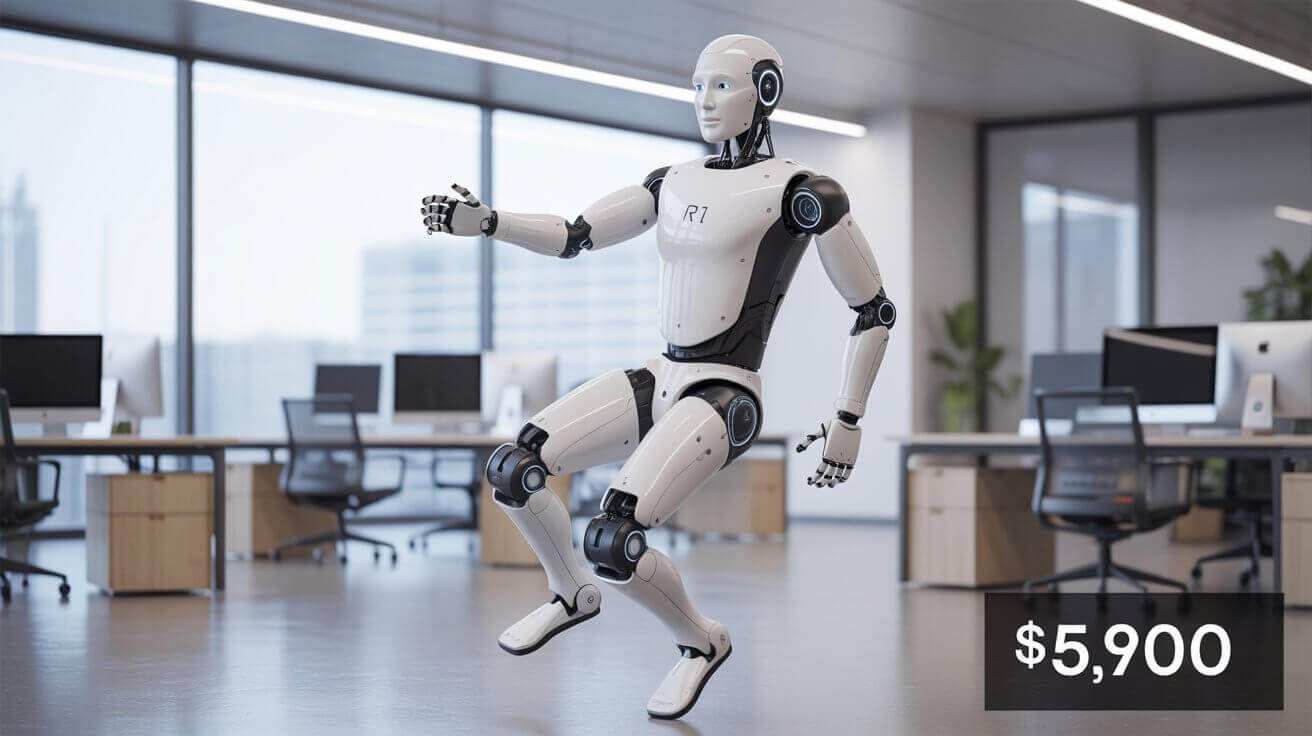Picture this: You walk into your office tomorrow and there’s a 4-foot humanoid robot doing cartwheels in the break room. Sounds like a fever dream, right? Well, buckle up because affordable humanoid robots just became reality. Unitree Robotics just dropped the R1 – a fully functional humanoid robot for $5,900. That’s less than what most people spend on a decent vacation, making it one of the most affordable humanoid robots ever released to the public.
I’m not talking about some clunky prototype that falls over when you sneeze. This thing does backflips, runs downhill like it’s training for the Olympics, and gets back up when it falls down. Meanwhile, affordable humanoid robots just went from “maybe in 2040” to “holy crap, I can buy one right now.”
The craziest part? This isn’t even the most expensive robot in Unitree’s lineup – it’s the budget option. And it’s about to change everything we thought we knew about affordable humanoid robots in business and daily life.
When Affordable Humanoid Robots Hit the $5,900 Sweet Spot
The Humanoid Robot Price Drop That Broke the Internet
Let me blow your mind with some numbers. Tesla’s Optimus? Elon says it’ll cost “under $20,000” when they’re pumping out a million units annually. Boston Dynamics’ Atlas? You probably can’t even get a quote without signing seventeen NDAs.
But here’s where it gets wild. Unitree’s own bigger robots cost way more – their G1 model runs $13,800, and their flagship H1 will set you back $90,800. So they basically said, “You know what? Let’s make something that costs less than a Honda Civic and can still do kung fu moves.”
According to Goldman Sachs Research, manufacturing costs for humanoid robots dropped 40% in just one year. We’re witnessing the smartphone moment for robotics – that sweet spot where technology gets good enough and cheap enough for everyone to jump in.

What Makes These Affordable Humanoid Robots Worth Every Penny
Here’s the thing that blows me away: despite the price, this isn’t some stripped-down disappointment. The R1 packs serious tech into its 25kg frame:
- 26 joints that move with scary precision
- AI brain that actually understands what you’re saying
- Binocular vision so it won’t walk into walls (hopefully)
- 4-microphone array because apparently robots are better listeners than my teenagers
- Wi-Fi 6 because even robots need good internet
- One hour runtime per charge (about as long as my attention span)
But forget the specs for a second. This robot was caught on video doing cartwheels, throwing punches, and running down hills like it’s auditioning for an action movie. These aren’t party tricks – they’re proof that affordable humanoid robots can handle real-world chaos.
The Numbers Don’t Lie: Affordable Humanoid Robots Market Explosion
Market Growth That’ll Make Your Head Spin
Ready for some numbers that sound like they’re from a science fiction novel? The humanoid robot market was $2.43 billion in 2023 and is projected to hit $24.04 billion by 2032. That’s a 29% annual growth rate.
But wait, it gets crazier. Morgan Stanley thinks the humanoids market could hit $5 trillion by 2050. Not billion – trillion. With a T. That’s bigger than most countries’ entire economies.
Why Everyone’s Going Crazy for Budget-Friendly Humanoid Robots Right Now
Three massive trends are colliding to make affordable humanoid robots inevitable:
AI Got Scary Good: Remember when chatbots could barely order pizza? Now robots can understand complex instructions, learn from mistakes, and adapt on the fly. It’s like giving them digital brains that actually work.
Components Got Dirt Cheap: All those sensors, motors, and processors that used to cost a fortune? They’re now mass-produced for smartphones and electric cars. The robot revolution is basically riding the coattails of your iPhone.
Workers Are Disappearing: Between aging populations and the Great Resignation 2.0, businesses are desperate for help. And unlike human workers, robots don’t call in sick, demand raises, or quit via TikTok video.
These Low-Cost Humanoid Robots Are Already Working Real Jobs
From Factory Floors to Hotel Lobbies
Here’s where it gets real: these aren’t just lab experiments anymore. Unitree’s bigger robots are already working at Nio and Geely, handling actual assembly line tasks at Chinese car factories. BMW is testing humanoid robots in their South Carolina plant, and Amazon has Agility’s Digit robots picking packages in warehouses.
But it’s not just big corporations. Smaller businesses are jumping in too:
- Restaurants using robots for food delivery and cleaning
- Hotels deploying them as concierges and room service assistants
- Retail stores having them help with inventory and customer questions
- Warehouses using them for sorting and moving packages
- Hospitals deploying them for medication delivery and patient assistance
The beauty of affordable humanoid robots like the R1 is that they can work in spaces designed for humans. No need to redesign your entire operation – just plug them in and let them learn.
The Budget Humanoid Robot Developer Gold Rush
This is where the R1 really shines. For the first time ever, universities, startups, and indie developers can afford to experiment with humanoid robotics. We’re talking about the same democratization that happened when personal computers went from $10,000 mainframes to $500 home machines.
Imagine computer science students learning to program robots instead of just websites. Picture small tech companies building specialized applications for different industries. Think about all the innovations that will come from thousands of brilliant minds having access to affordable humanoid robots.
How Affordable Humanoid Robots Change the Game for Business
Small Business Revolution with Cost-Effective Humanoid Robots
Here’s what gets me excited: a small restaurant can now afford a robot host. A local gym can have a robot that cleans equipment and answers questions. A boutique store can deploy a robot for inventory management during busy seasons.
These affordable humanoid robots don’t require massive infrastructure changes. They work in human spaces, understand human language, and adapt to different tasks. It’s like hiring a really patient, never-tired employee who works for the cost of electricity.
The Human-Robot Team-Up
Contrary to what Hollywood taught us, robots aren’t coming to steal our jobs – they’re coming to make our jobs less awful. Research shows that humanoid robots excel at dangerous, dirty, and dull tasks that humans would rather avoid anyway.
Think about it: would you rather have a human climbing into a chemical tank for inspection, or send a robot that doesn’t mind toxic fumes? Would you prefer a person doing repetitive assembly line work for 12 hours, or let a robot handle it while humans focus on creative problem-solving?
The companies getting this right are training workers to manage and collaborate with robots, not replacing them entirely.
What’s Next for the Affordable Humanoid Robots Industry
The Low-Cost Humanoid Robot Technology Train Has No Brakes
The R1 is impressive, but it’s just the opening act. Here’s what’s coming down the pipeline:
Better Hands: Current robots are still clumsy with delicate tasks. That’s changing fast with new materials and control systems.
Longer Battery Life: All-day operation is coming, probably sooner than you think.
Smarter AI: We’re talking robots that can reason, plan multiple steps ahead, and handle unexpected situations like humans do.
Even Cheaper Prices: As production scales up, these costs will keep dropping. Think about how much smartphones cost in 2007 versus today.
The Global Race for Cheap Humanoid Robot Dominance
Here’s where geopolitics gets interesting. China has filed 5,688 humanoid robotics patents over the past five years – almost four times more than everyone else combined. They’re not just playing catch-up; they’re trying to dominate the field.
Meanwhile, Western companies are betting on superior AI software and specialized applications. The competition is fierce, which means better robots and lower prices for everyone.
Your Affordable Humanoid Robot Strategy Playbook
Is Your Business Ready for Budget Humanoid Robots?
Not every business needs a humanoid robot tomorrow, but you should start thinking about it if you have:
- Tasks that are repetitive but require some mobility
- Safety concerns that keep you up at night
- Positions that are hard to fill or have high turnover
- Operations that run 24/7 and could benefit from tireless workers
Start Small, Think Big
The genius of affordable humanoid robots like the R1 is that you can test the waters without betting the farm. Start with one specific use case, measure the results, and expand gradually.
Partner with local universities or robotics developers. Many are looking for real-world testing environments and might work with you on pilot programs.
The Reality Check We All Need
It’s Not All Sunshine and Robots
Let’s be honest – this technology isn’t perfect yet. Current humanoid robots still struggle with complex manipulation tasks, unexpected situations, and anything requiring deep creative thinking. The R1 doesn’t even have functional hands in its base configuration.
Battery life is still limited, maintenance requirements are unclear, and we’re all learning how to integrate these machines into human workspaces safely.
The Questions We Haven’t Answered
How do customers react to robot service? What happens when these machines break down? How do we train workers to collaborate effectively with artificial colleagues? What are the insurance implications?
These are the growing pains of any revolutionary technology. The businesses that figure out these challenges first will have massive advantages.
The Future Is Knocking on Your Door
The Unitree R1 isn’t just another gadget – it’s the moment when affordable humanoid robots became reality instead of fantasy. At $5,900, we’ve crossed the threshold where experimentation becomes viable for everyone from Fortune 500 companies to college students.
We’re living through the early days of a transformation that will reshape work, business, and daily life. The companies and individuals who start exploring these capabilities now will be the ones defining how this technology evolves.
The age of affordable humanoid robots isn’t coming – it’s here. And honestly? It’s about time we had some help with all the stuff we’d rather not do ourselves.
So the question isn’t whether humanoid robots will become commonplace. The question is: when they do, will you be leading the charge or scrambling to catch up?








